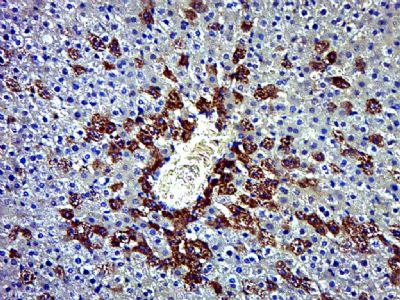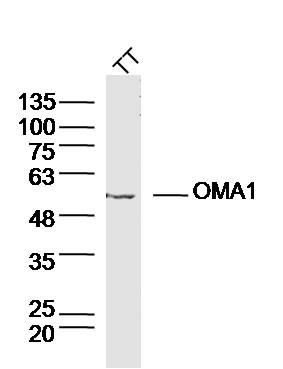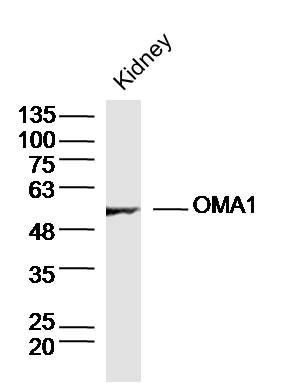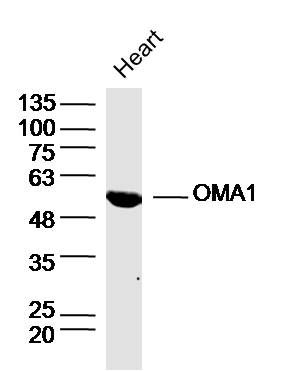OMA1 Polyclonal Antibody
Purified Rabbit Polyclonal Antibody (Pab)
- 产品详情
- 实验流程
Application
| WB, IHC-P, IHC-F, IF |
|---|---|
| Primary Accession | Q96E52 |
| Reactivity | Human, Mouse, Rat |
| Predicted | Rabbit, Zebrafish, Pig, Bovine |
| Host | Rabbit |
| Clonality | Polyclonal |
| Calculated MW | 60120 Da |
| Physical State | Liquid |
| Immunogen | KLH conjugated synthetic peptide derived from human OMA1 |
| Epitope Specificity | 401-500/524 |
| Isotype | IgG |
| Purity | affinity purified by Protein A |
| Buffer | 0.01M TBS (pH7.4) with 1% BSA, 0.02% Proclin300 and 50% Glycerol. |
| SUBCELLULAR LOCATION | Mitochondrion membrane. |
| SIMILARITY | Belongs to the peptidase M48 family. |
| Post-translational modifications | In normal conditions, cleaved into an inactive 40 kDa form. Following CCCP treatment that induces loss of mitochondrial membrane potential, the 40 kDa form is reduced in favor of an active 60 kDa form. |
| Important Note | This product as supplied is intended for research use only, not for use in human, therapeutic or diagnostic applications. |
| Gene ID | 115209 |
|---|---|
| Other Names | Metalloendopeptidase OMA1, mitochondrial, 3.4.24.-, Metalloprotease-related protein 1, MPRP-1, Overlapping with the m-AAA protease 1 homolog, OMA1 {ECO:0000303|PubMed:20038677, ECO:0000312|HGNC:HGNC:29661} |
| Target/Specificity | Widely expressed, with strong expression in the heart, skeletal muscle, kidney and liver. |
| Dilution | WB=1:500-2000,IHC-P=1:100-500,IHC-F=1:100-500,ICC=1:100-500,IF=1:100-500 |
| Format | 0.01M TBS(pH7.4) with 1% BSA, 0.09% (W/V) sodium azide and 50% Glyce |
| Storage | Store at -20 °C for one year. Avoid repeated freeze/thaw cycles. When reconstituted in sterile pH 7.4 0.01M PBS or diluent of antibody the antibody is stable for at least two weeks at 2-4 °C. |
| Name | OMA1 {ECO:0000303|PubMed:20038677, ECO:0000312|HGNC:HGNC:29661} |
|---|---|
| Function | Metalloprotease that is part of the quality control system in the inner membrane of mitochondria (PubMed:20038677, PubMed:25605331, PubMed:32132706, PubMed:32132707). Activated in response to various mitochondrial stress, leading to the proteolytic cleavage of target proteins, such as OPA1, UQCC3 and DELE1 (PubMed:20038677, PubMed:25275009, PubMed:32132706, PubMed:32132707). Involved in the fusion of the mitochondrial inner membranes by mediating cleavage of OPA1 at S1 position, generating the soluble OPA1 (S-OPA1), which cooperates with the membrane form (L-OPA1) to coordinate the fusion of mitochondrial inner membranes (PubMed:31922487). Following stress conditions that induce loss of mitochondrial membrane potential, mediates cleavage of OPA1, leading to excess production of soluble OPA1 (S-OPA1) and negative regulation of mitochondrial fusion (PubMed:20038677, PubMed:25275009). Involved in mitochondrial safeguard in response to transient mitochondrial membrane depolarization (flickering) by catalyzing cleavage of OPA1, leading to excess production of S-OPA1, preventing mitochondrial hyperfusion (By similarity). Also acts as a regulator of apoptosis: upon BAK and BAX aggregation, mediates cleavage of OPA1, leading to the remodeling of mitochondrial cristae and allowing the release of cytochrome c from mitochondrial cristae (PubMed:25275009). In depolarized mitochondria, may also act as a backup protease for PINK1 by mediating PINK1 cleavage and promoting its subsequent degradation by the proteasome (PubMed:30733118). May also cleave UQCC3 in response to mitochondrial depolarization (PubMed:25605331). Also acts as an activator of the integrated stress response (ISR): in response to mitochondrial stress, mediates cleavage of DELE1 to generate the processed form of DELE1 (S- DELE1), which translocates to the cytosol and activates EIF2AK1/HRI to trigger the ISR (PubMed:32132706, PubMed:32132707). Its role in mitochondrial quality control is essential for regulating lipid metabolism as well as to maintain body temperature and energy expenditure under cold-stress conditions (By similarity). Binds cardiolipin, possibly regulating its protein turnover (By similarity). Required for the stability of the respiratory supercomplexes (By similarity). |
| Cellular Location | Mitochondrion inner membrane; Single-pass membrane protein {ECO:0000250|UniProtKB:Q9D8H7} |
| Tissue Location | Widely expressed, with strong expression in the heart, skeletal muscle, kidney and liver |
Research Areas
For Research Use Only. Not For Use In Diagnostic Procedures.
Application Protocols
Provided below are standard protocols that you may find useful for product applications.
终于等到您。ABCEPTA(百远生物)抗体产品。
点击下方“我要评价 ”按钮提交您的反馈信息,您的反馈和评价是我们最宝贵的财富之一,
我们将在1-3个工作日内处理您的反馈信息。
如有疑问,联系:0512-88856768 tech-china@abcepta.com.
¥ 1,500.00
Cat# AP57606























 癌症的基本特征包括细胞增殖、血管生成、迁移、凋亡逃避机制和细胞永生等。找到癌症发生过程中这些通路的关键标记物和对应的抗体用于检测至关重要。
癌症的基本特征包括细胞增殖、血管生成、迁移、凋亡逃避机制和细胞永生等。找到癌症发生过程中这些通路的关键标记物和对应的抗体用于检测至关重要。 为您推荐一个泛素化位点预测神器——泛素化分析工具,可以为您的蛋白的泛素化位点作出预测和评分。
为您推荐一个泛素化位点预测神器——泛素化分析工具,可以为您的蛋白的泛素化位点作出预测和评分。 细胞自噬受体图形绘图工具为你的蛋白的细胞受体结合位点作出预测和评分,识别结合到自噬通路中的蛋白是非常重要的,便于让我们理解自噬在正常生理、病理过程中的作用,如发育、细胞分化、神经退化性疾病、压力条件下、感染和癌症。
细胞自噬受体图形绘图工具为你的蛋白的细胞受体结合位点作出预测和评分,识别结合到自噬通路中的蛋白是非常重要的,便于让我们理解自噬在正常生理、病理过程中的作用,如发育、细胞分化、神经退化性疾病、压力条件下、感染和癌症。










